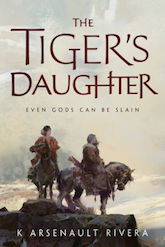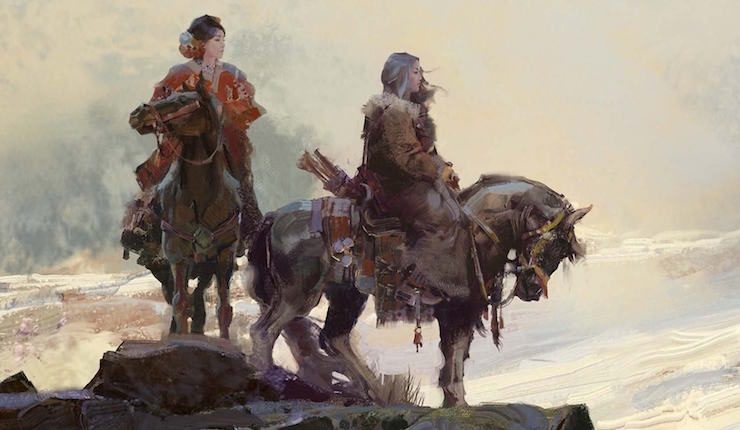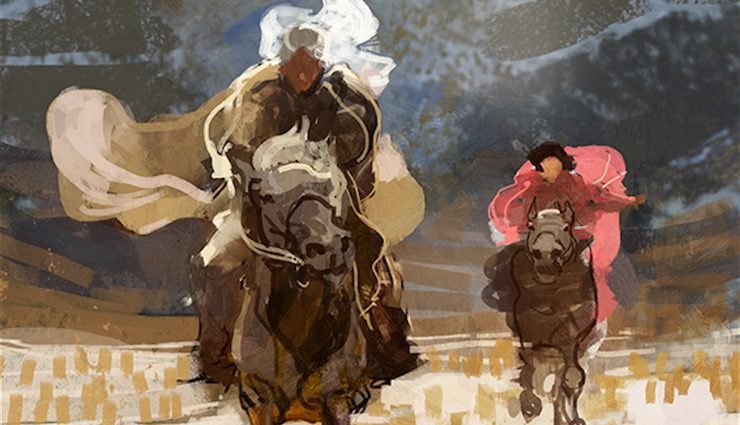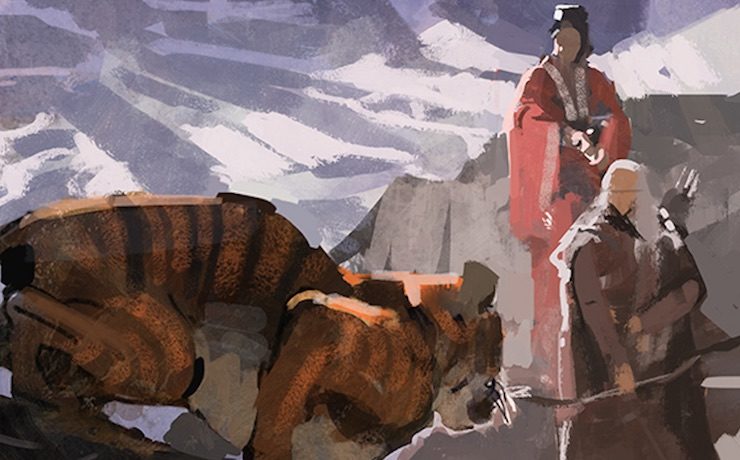In which I recreate my experience reading K. Arsenault Rivera’s The Tiger’s Daughter the only way that seems appropriate: through letters. Some spoilers for the novel.
Shefali. O-Shizuka. We need to talk.
You’re out of control. You run through palace gardens fending off tigers, and camp out on the Silver Steppes grappling with demons around the fire. You’re so convinced that you’ve been touched by the gods because you’ve been able to escape tiger attacks without getting mauled, just some claws to the shoulder.
You dream of patrolling the land—Shefali picking off demons from afar with your bow, or, for the ones that get too close, O-Shizuka slashing them with the sword. The two of you will be beholden to none of the responsibilities of the throne nor of the tribe, free to do nothing but play warrior until you have racked up enough demon kills to actually assume the title.
It’s a lovely dream, but one of you has to grow out of it. You can’t both be warriors.
Buy the Book


The Tiger’s Daughter
It’s just too redundant. It’s hard enough shoehorning one woman into a story; even if two can sneak in, they can’t inhabit the same role, because then what would be the point?
It’s the paramount playground rule: You can’t both be Princess Leia. One of you gets to be the Alderaanian princess, racing across the galaxy fighting the Empire, while the other has to hold down the Rebel base as Mon Mothma. Or, nowadays you can be the Jedi-in-training (Rey), Rebel spy (Jyn Erso), New Order stormtrooper (Captain Phasma), Resistance maintenance worker (Rose Tico)… But there are not two princesses. Not two Jedi. Not two spies. Not two lady stormtroopers. Not two maintenance workers. Also, you can’t share screentime for more than five minutes.
Don’t look at me like that! I didn’t make the rules.
What, like Sansa and Arya Stark were both going to choose the sword? One was clearly the lady, the other the warrior. Arya could no more adapt to wearing gowns and elaborate hairstyles than Sansa could stab people with Needle or snatch their faces. They know their place—more, they know their roles.
Puberty is where the issue becomes clear. Girls can run around slaying demons, but women must let themselves get slotted into roles that are complementary, or proportional, to one another. Not the same image layered one on top of the other, so that you can’t discern which one is which.
I took up the [insert weapon] and defended my [insert family/tribe/subjects] from [insert enemy].
Who wants to hear the same story twice?
Let’s be serious. One of you is going to put down your weapon and pick up something else: a fan, a calligraphy brush, I don’t know, a spoon? Or maybe you don’t need to hold anything. You can just sit there and work on the public face you’ll present to the rest of the world. Poets can write scrolls and scrolls about how pretty and/or forbidding you look.
Maybe that’s you, O-Shizuka. After all, you’re the niece of the Emperor and do have a lot of responsibilities demanding your time and attention, like practicing calligraphy and fending off suitors. That’s, like, your whole day right there!
But Shefali, you have just as much opportunity to follow Alshara’s footsteps as Kharsa. It’s not too late to learn your mother’s sign language, so that you can take the role of her interpreter and, in doing so, absorb all of her teachings for your eventual ascendance to ruling the Qorin people.
You’re both equally poised to take over a throne—or saddle—just waiting for you. One of you just has to choose.
…
No? Neither of you will budge?

Look, there might have been a loophole if you two weren’t friends, or if you were pen pals who lived in very distant regions so that no one could confuse one warrior for another. If you didn’t insist on going everywhere together, reminding everyone that here are two warriors occupying the narrative space where just one is needed. A warrior and a farm girl she picked up on the way? Fine. A warrior and her royal friend? Awesome. But two warriors? How will they tell you apart?
The sword and the bow, you say. Sure, they’re different weapons. And, OK, they actually match your personalities and temperaments weirdly well—Shizuka, getting in people’s faces and wielding an inherited blade like the deadly status symbol it is; Shefali taking the time and effort to construct her bow, to create exactly the instrument that matched her needs, ever thoughtful, always slightly removed so that she could consider every step that leads up to letting that arrow fly. Shizuka’s sword representing its own bloody lineage, while Shefali’s bow is, like her tribe’s passage of power, self-made.
Speaking of bloodlines, where are your mothers? This is usually the point in the story where your moms shake some sense into you, remind you of fancy balls or marriage proposals or honor. If nothing else, it’s a reminder that you’re only friends because your mothers happened to be pregnant at the same time. It’s no more destiny than The Sisterhood of the Traveling Pants is.
Except that your mothers… instead of being yoga buddies… were also a demon-hunting duo.
O-Shizuru, the Emperor’s champion, his not-so-secret weapon, whose cocky grin was even more dangerous than her sword.
Burquila Alshara, the Kharsa, who slew her own brothers in order to take her rightful place in control, who amassed hundreds of allies without speaking a word, who blew a hole in the Wall of Stone with Dragon’s Fire.
Bonded by eight days of torture, bound by friendship for decades after.
But women don’t pass on warrior teachings to their daughters. Lady warriors are supposed to be singular—the first in a generation, or even a century, to be safe. Their identity hinges on existing in a vacuum—on being the one, plucky, tomboyish girl who decides to buck propriety and take on the mantle of a warrior right as people’s memories of the last long-dead lady knight were beginning to crumble into ash. You can’t have two generations of lady warriors in one story; one flesh-and-blood fighter must be balanced out by one distant legend.
If there have to be two lady warriors alive at the same time, then they can only meet up occasionally, mostly just for showdowns.
So, this whole thing with mothers living long enough to pass down actual training directly to their daughters just doesn’t track. That’s just a surplus of protectors of the realm. How are there even enough weapons for everyone?
O-Shizuka, I know you inherited your mother’s sword, but… Well, it just doesn’t work like that. Who do you think you are, Luke Skywalker picking up Anakin’s lightsaber? Aragorn, bequeathed the shards of his ancestor Elendil’s sword Narsil? You couldn’t have inherited your father’s calligraphy brush instead?
Oh. You inherited O-Shizuru’s sword because… because you had to kill her with it. To extinguish the demon that had taken over her body, her greatest nightmare.
I took up my mother’s sword and defended my beloved from the people who would destroy her.
And you, Shefali, you had to create a new bow after your old one was—and the demon—and your body—
I took up my bow and defended myself from ancient evils.
You know what? I’m not going to change your mind. Carry on.

And thank you, for proving me wrong.
Don’t even get Natalie Zutter started on Shizuka and Shefali both being Chosen Ones. Which is to say, it’s so great. Talk fantasy tropes with her on Twitter!











Must read soon.
Just finished reading yesterday. Good aspects to highlight, and definitely this is the positive side to what the author accomplished. Tor has really gotten behind this author in the marketing department, which is fantastic. But I just can’t let that pass without noting that once again there’s avoidance of comment on the problematic China/Japan model in this novel. I think you’re doing the author and her work a disservice by taking the silence-is-golden tactic. Open dialogue would be a better approach, especially when there’s a sequel on the way. [Comment edited by author, on reflection]
Would you mind explaining what aspects you find problematic? I’ve read the book, and yes, I saw the one-star review on Goodreads. However, that review was based only on the first four chapters on the book, and many of the “mistakes” mentioned are addressed later on. The book depicts an Imperial Japan that is not an archipelago and that has managed to conquer most of its neighbors. Due to this merger, elements of both Japan and China are present in the culture that Shizuka comes from. Is it this idea that you find problematic, or something specific in how Rivera depicts it?
I read the first couple of chapters on tor.com and was not captivated but I don’t see why the China/Japan, and Mongol, inspired background is a problem.
I’m not going to pose as a China or Japan expert (I’m neither), but the touchstones are too close for this novel to stand entirely free of them as presenting its own original society. There’s strong echoes here of real-life Japan, China and Mongolian history and interactions, prejudices, etc. that I understand are offending people with a background in these cultures, since it doesn’t choose to address them but takes them as a given. I don’t think this can be directly compared with a British-French-German etc. European blend we typically see for ease of use. Presenting a variety of sexual orientation profiles is made much of on this forum, and this novel deserves these kudos for the example it sets, but so has presenting a variety of cultures in a respectful way and so far I’ve seen nothing here that takes any position where this novel is concerned, despite the many related articles. Which feels to me like an odd and noteworthy silence. I’d just like to see some dialogue taking place, or am I the only one who wonders about this? My interest in it is, I’ve dabbled with this kind of writing myself and I’m trying to find where the lines are.
Monster-slaying lady warrior is itself a fantasy trope.
A modern trope. A fashionable trope. But not the sort of person you could expect to stumble across in the historic East Asia…
Asian history boasts some pretty tough ladies, even the odd warrior or two. I admit an equal opportunity Chinese/Japanese Empire raised an eyebrow, but then I raise an eyebrow at sexually egalitarian western medieval based fantasies too. Desirable of course but not very realistic. Still if you’re going to have magic and monsters why not sexual equality?
Okay, it is fair to say that this book doesn’t explore the relationships between the cultures in the book as much as it could have. But I do think that Rivera does a pretty decent job considering the focus of her story. At it’s heart, The Tiger’s Daughter is a love story. It’s the tale of two badass girls from very different cultures who are destined to fall head-over-heels in love and band together to save their world. Thus the two main things that both protagonists focus on are each other and the threat of the demons infesting the world. They also think a lot about their immediate families and the Emperor, who is trying to marry Shizuka off. What they don’t think about as much is the political situation between their two peoples. You can certainly take this as a flaw if you like, but Rivera had a lot to do already, packing in tons of cultural, historical, and familial details into the story of her protagonists’ childhood and teenage years. Also, it’s not like explanations about the political situation are non-existent either. We get the basic history of the Hokkaran-Qorin war and how those relations were haphazardly repaired. There is only so much that you can put in and still have a streamlined product.
Maybe some people came to this book really wanting a story that delved into the complex relationships between East Asian countries, and were disappointed to find that this isn’t that story. That’s perfectly okay. But I don’t think it’s right to label this book as “problematic” just because it was trying to be something else.
Whether this novel’s example in particular is “problematic” is up for debate (and I’m appreciating the perspectives here). I meant to apply “problematic” to the greater sphere of adapting the Chinese-Mongolian-Japanese model into a work of fiction, which has a lot of fairly recent history that appears to need careful navigating if the model is going to steer close enough to real life that they can be identified and their relations are being echoed.
The first few chapters are okay, but then this novel sags massively. Silvera is a good writer, but the vehicle of the letter sucked all the action out of the story and I lost interest pretty quick. I slogged through to the end, but I wasn’t happy with it.
17th paragraph down you mean “insist on” not “exist on” ;-
@10, usually the description of an unusual culture sucks me in, not this time. By the second preview chapter I was thinking ‘this is a mess’ and lost interest.
@11 – Fixed, thank you!
@5 cecrow I think the issue is precisely that the background is in that middleground of being recognizably real world history but distorted enough to be annoying.
If this had been straight up historical fiction that was impeccably researched before adding the fantasy element, nobody would have a problem with the setting. And if it had been like REH’s Conan where you can see Europe if you squint but treat it as fully fictional if you want, then that’s OK too. But being in the middle ground it can do nothing but annoy people who are familiar with the real world cultures or history.
That said, I think the kerfuffle over the setting is overblown, especially if you are a reader who isn’t familiar with the real world setting (for example, I have no idea how verisimilar Alif the Unseen is, but I still mostly enjoyed it). I think the real issue with this book is it is such a slow burn. I almost always finish books, but this was a DNF for me. I couldn’t get through it before my library loan period was up.